Ita Yachts Canada
Brokerage / Courtage

Understanding the Classification of Yachts A, B, C and D
Understanding the Classification of Yachts A, B, C and D:
Since 1998, Europe (EEC) classifies yachts according to 4 categories A or B or C or D and this is a law. In order to sell a boat in the large territory of the EEC, it must be classified with a plate that mentions its classification and it must be clearly visible inside the boat, usually near the helm.

At first glance, it sounds very good when you hear class A, but what is it really, what are the differences, is it necessary to acquire a class A…
The brokers at ItaYachtsCanada have written an article on this subject in the past ( click here ), but here are the important characteristics to know about the subject.
The classification allows you to know in which kind of sea intensity you can safely venture, that is to say, taking into account the wind and the wave height in reference to the Beaufort index.
(At the end of this text, there is an explanation of the classes according to the Beaufort index).
Let’s say we focus on class A and B, on the major differences.
First of all, the differences are not very visible to the naked eye or it takes a trained eye to see them.
Depending on the type of water you plan to sail and if the weather guides you on each trip, a B class is also a very good choice.
Of course, you must have all the required safety equipment on board.
Ideally, a boater should always sail in rather peaceful conditions, taking into account the weather first. We always say that boating is fun, so stay away from difficult sailing situations. (Ideally, always with a Beaufort index of 6 and less, ideally a Beaufort index of 4 and less).
Many manufacturers have retained the parameters of the B class to build their boats, mainly for reasons of production costs and that boaters in general do not care much about these characteristics.
The problem is how to differentiate between the vast range of B class boats, how to distinguish those that are closer to an A class (B +) from those that are built as (B -).
How to find your way around, especially for a layman…

It is important to know that some manufacturers build their boats with an A approach, but without respecting all the mandatory specifications to be classified A.
Here are some guidelines to quickly see if the manufacturer has done things right.
– Inspect the portholes and closing mechanisms (Plastic or Metal)
– The presence of numerous drains to evacuate water (at the fly and cockpit), it is essential to be able to evacuate any water accumulation quickly.
– Height of the freeboard.
– Engine access hatch, well insulated and secured for water leaks.
– Bilge pumps (number, size and capacity)
– Mechanism to pump water from the engine room massively (e.g. possibility to use the engine water pumps with a joystick)
– The center of gravity of the boat is well balanced (rather low).
Hull joints, a very low center of gravity, excellent weight distribution, electrical system (24 V), are also part of the certification criteria especially for A boats, but difficult to assess for a yachtsman. It is possible, but in a summary way.
The CE classification allows to differentiate yachts according to certain criteria present, we are talking mainly about structural strength, integrity of essential parts of the hull, reliability of propulsion, steering systems, power generation and all other features installed on board to help ensure the essential services of the yacht.
Therefore, it is important to understand that a Class A yacht is built to a much higher standard than a Class B. This is not reflected in the luxurious appearance of the boat.
What you have to remember is that the major enemy for a boat, besides a fire, is water infiltration on board which can destabilize the behavior of the boat, cause a stop of the engines, major electrical problems, in short which can quickly put the boat out of use and/or out of control.
A classification body such as RINA (see list at the end of this text) has been checking the activities of builders and classifying yachts for over 20 years.
If the boat is sold in the European Community, the classification is mandatory and must be visible near the cockpit. This same classification is not present when the boat is intended for North America or very rarely.
Do not hesitate to contact a professional broker, he will be able to guide you according to your needs, your criteria and especially the places of navigation.

As the CE classification is not always displayed when the boat is destined for the North American market, here are some references on this subject based on the most recent data available (subject to change without notice):
P.S. Let’s mention that as a general rule yachts over 80 ft are Class A, but according to the rules in place, the classification is no longer mandatory or mentioned beyond 79 ft.
Class A (yachts over 50 ft):
BEST KNOWN MODELS :
Ferretti 500, 550, 670 and up
Pershing : 7X and up
Azimut 62, 64, 66, 68 Fly and up
Azimut S8 and up
Azimut Magellano : the whole range
Sunseeker Sport yacht 65, Yacht 88 and up
Princess yacht 80 and up (TBC)
Marquis Yachts (no longer in production)
Montecarlo MCY 66 and up
Searay L650
Class B (yachts over 50 ft):
Sunnseeker 52 fly, 55 fly , 66 fly, 68 fly, Sport Yacht 74, 76 Yacht
Azimut 50 fly, 55 fly, 60 fly, S6 and all Atlantis
Princess : all yachts under 70 ft
Princess Y72, Y78 and less
Ferretti 580 fly
All Absolute
All Fairline
All Beneteau & Jeanneau & Monte Carlo 52
All Searay except L650.
All Cruisers Yachts
For more information, here is an article published by the brokers at ItaYachtsCanada, click here .
There is also the dry weight which can help determine a quality yacht.
Don’t hesitate to compare yachts of the same size based on dry weight, you may be surprised.
For example, a 52′ yacht that weighs 30,000 lbs empty compared to another one that weighs 60,000 lbs empty, ask yourself some questions.
But be careful, it is more and more difficult to get the manufacturers’ empty weights. They have understood the importance of being rather vague on the subject or of making comparisons more difficult. Indeed, we are talking about LIGHT WEIGHT, which is difficult to measure.
The manufacturer who has confidence in thier boat will have no difficulty in giving a total warranty of at least 12 months, 24 and even 36 months. Please note the difference here between the manufacturer’s warranty and the dealer’s warranty .
Many European manufacturers sell their boats to dealers in America without a warranty. This means that the dealer assumes the full 12-month warranty out of his profit from the sale. The engine manufacturer, on the other hand, honors its own warranty such as Volvo, Cummins, Caterpillar, MAN, MTU, Yanmar. For other major components, it will be up to you to take the necessary steps to have the warranty honored, such as for the generator, the air conditioning, the thrusters, etc…

Therefore, acquiring a boat requires a much more specialized expertise than that of a car! Contact ITA Yachts Canada Inc. to speak with a professional and independent broker with experience in the following markets (Canada, United States and Europe whether the boat is new or used).
MORE INFORMATION.
Here is some more information about the classification, what the law in Europe says about it.

Here are some links to help you understand the Beaufort index in direct relation with the classification of yachts sold on the territory of the EEC:
Click here for the TRANSPORT CANADA website
Click here for an article on Wikipedia (more descriptive with photo).
According to the EEC rules, here is the description:
The classification of vessels marked “CE
CE marked vessels are classified into four design categories according to their ability to cope with sea conditions characterized by wind speed and significant wave height. Depending on the type of navigation practiced, the boater must choose a vessel whose design category authorizes such practice.
– Design Category A: Recreational vessels designed for winds that can exceed force 8 (on the Beaufort scale) and for waves that can exceed a significant height of 4 meters, excluding exceptional conditions such as storms, severe storms, tornadoes and extreme sea conditions or huge waves (these conditions exclude force 10 and following).
– Design Category B: Pleasure craft designed for winds up to and including force 8 and for waves up to and including 4 meters in significant height.
– Design Category C: Pleasure craft designed for winds up to and including force 6 and for waves up to and including two meters in significant height.
– Design Category D: Pleasure craft designed for winds up to and including force 4 and for waves up to and including 0.30 meters, with occasional waves up to and including 0.50 meters.

Vessels in each of these design categories shall be designed and constructed to withstand the parameters of each of these categories, with respect to buoyancy, stability and other relevant requirements, and to have good maneuverability characteristics.
The known classification bodies for the EEC:
RINA (Registro Italiano Navale),
BV (Bureau Veritas),
DNV (Det Norske Veritas),
Germanischer Lloyd,
LR (Lloyd’s Register).

Ita Yachts Canada provides the information in this article in good faith but cannot guarantee the accuracy of the information or the status of the data. It is the responsibility of the reader to instruct their agents or experts to verify and validate the information in this article.
Share this:
Published by Guy Bolduc
View all posts by Guy Bolduc
Leave a Reply Cancel reply
Discover more from ita yachts canada.
Subscribe now to keep reading and get access to the full archive.
Type your email…
Continue reading
- CATAMARAN MOTEUR
- CATAMARAN VOILE
- CENTER CONSOLE
- FISHING BOAT
- SPORT BRIDGE
- ABSOLUTE YACHTS
- CRUISERS YACHTS
- FOUNTAINE PAJOT
- GRAND BANKS
- KADEY-KROGEN
- MOCHI CRAFT
- MINIGHT EXPRESS
- MONTE CARLO
- NORTHERN MARINE
- OCEAN ALEXANDER
- OUTBACK YATCHS
- PARDO YACHTS
- PRESTIGE YACHTS
- SILENT YACHTS
- $1,5 M to $2,9 M
- $3,0 M to $4,9 M
- $5,0 M to $6,9 M
- $7,0 M to $9,9 M
- $10,0 M and more
- UNDER 49 FEET
- 50 to 59 FEET
- 60 to 69 FEET
- 70 to 79 FEET
- 80 to 89 FEET
- 90 to 99 FEET
- MORE THAN 100 FEET
- CENTRAL AMERICA
- PERSIAN GULF
- UNITED-STATES OF AMERICA
- YACHTS REGISTERED UPDATED
- VIRTUAL TOUR 3D
- YACHTS FOR SALE
- IMPORT-EXPORT
- BLOGUES, NOUVELLES ET CONSEILS
- PODCAST VIDEO

The global authority in superyachting
- NEWSLETTERS
- Yachts Home
- The Superyacht Directory
- Yacht Reports
- Brokerage News
- The largest yachts in the world
- The Register
- Yacht Advice
- Yacht Design
- 12m to 24m yachts
- Monaco Yacht Show
- Builder Directory
- Designer Directory
- Interior Design Directory
- Naval Architect Directory
- Yachts for sale home
- Motor yachts
- Sailing yachts
- Explorer yachts
- Classic yachts
- Sale Broker Directory
- Charter Home
- Yachts for Charter
- Charter Destinations
- Charter Broker Directory
- Destinations Home
- Mediterranean
- South Pacific
- Rest of the World
- Boat Life Home
- Owners' Experiences
- Conservation and Philanthropy
- Interiors Suppliers
- Owners' Club
- Captains' Club
- BOAT Showcase
- Boat Presents
- Events Home
- World Superyacht Awards
- Superyacht Design Festival
- Design and Innovation Awards
- Young Designer of the Year Award
- Artistry and Craft Awards
- Explorer Yachts Summit
- Ocean Talks
- The Ocean Awards
- BOAT Connect
- Between the bays
- Golf Invitational
- BOATPro Home
- Superyacht Insight
- Global Order Book
- Premium Content
- Product Features
- Testimonials
- Pricing Plan
- Tenders & Equipment
Classification: Statutory certification explained
Is certification an unnecessary complication, the costs and hassle of which far outweigh the benefits, or a helpful and reassuring framework which sets the highest standards for structural and operational safety and safeguards life, property and the sea environment?
No one could possibly deny that the large yacht industry is, and has been for some time, in the throes of a boom in spite of a recent downturn since 2008. Some observers would suggest that this is in spite of all the new rules and regulations that seem set to dog the yacht owner’s every move. Others would suggest that it is through the introduction of rules and regulations such as the MCA’s Code of Practice for Safety of Large Commercial Sailing and Motor Vessels that the industry has been given the confidence to expand with such vigour, knowing that their investments are safer – both financially and physically – because of regulation.
Classification societies are non-governmental organisations or groups of professionals, ship surveyors and representatives that develop, publish and certify standards and technical rules to ensure an acceptable degree of stability, safety and environmental impact, among other things. They are authorised to certify yachts and vessels flagged virtually anywhere.
A classification certificate attests that the yacht complies with the standards developed and published by the issuing society
New construction and refit surveys carried out by a surveyor from the classification society under which the yacht is built are important inspections that take place at intervals throughout the duration of the project. They ensure that any and every installation, repair, upgrade or modification is carried out to the standards of that society. Classification surveyors are interested in the structural integrity of the hull, installation of equipment, stability, structural, engine and machinery surveys, electrical, electronic and ancillary equipment, rigging inspections, safety recommendations and ultrasonic thickness gauging.
Every owner has his own vision of what he wants his yacht to be and designers strive to deliver just that. The fulfillment of this vision in turn becomes paramount in the eyes of the building yard and others who represent the owner, so it is often the policies imposed in the form of building regulations and classification rules that act as the voice of reason. This ultimately allows a balance to be struck between the attainment of that vision and the safety and reliability embodied in the construction of a yacht built to class.
A classification certificate attests that the yacht complies with the standards developed and published by the issuing society. Periodic surveying of a yacht in service by the appropriate class surveyor, at intervals dictated by the appropriate classification society, is also required to ensure the vessel continues to meet the rules and thus maintain her in-class status. Should any defects that may affect class become apparent, or if damage is sustained between surveys, the owner or operators are required to inform the society concerned without delay.
Almost every yacht that is launched is bigger or in some way better than the last and, quite often, more complex than its predecessor
As independent, self-regulating bodies, classification societies have no commercial interest in design, building, ownership, operation, management, maintenance, repairs, insurance or chartering. Classification rules are not intended as a design code and, in fact, cannot be used as such. These are more generally covered by the flag state, which lays down standards, or codes of practice that dictate construction good practice.
Almost every yacht that is launched is bigger or in some way better than the last and, quite often, more complex than its predecessor. As this trend continues, so too is the involvement and role of classification societies increasing and evolving. But what exactly does classification entail, and how is it linked to the statutory requirements of the various flag states? These matters are often misunderstood, which can potentially result in a conflict of responsibility.
Classification
The classification process The classification of yachts may be regarded as the development and worldwide implementation of published rules and regulations which – in conjunction with proper care and conduct on the part of the builder, owner and operator – provides for the structural strength and, where necessary, the watertight integrity of the hull. The same rules cover any appendages to the hull itself.
Classification rules lay down regulations that govern the effectiveness, safety and reliability of the propulsion and steering systems and other features, as well as the auxiliary systems which establish and maintain basic conditions on board and ensure that guests and crew can be safely carried while the yacht is at sea, at anchor, or moored inside a harbour.
Owners sometimes see classification as an unnecessary complication offering no real advantage for the cost. Some even suggest that the classification societies exist simply to make a profit out of a yacht builder’s desire to build a saleable product.
‘This is a misconception and one that needs to be addressed,’ Paul Martin, a principal engineer at DNV, points out: ‘Classification societies are independent bodies without a commercial stake in the build, and are therefore in a unique position to make sure that the yacht meets requirements without considering commercial impact. This enables yachts to be built with safety of the yacht, her crew, other vessels and the environment given maximum priority, irrespective of cost.’
Owners sometimes see classification as an unnecessary complication offering no real advantage for the cost
‘Because most classification societies have enormous experience,’ he continues, ‘as well as a lot of data on the failure of various types of vessels, machinery and other connected disciplines, they can bring these to bear on new projects ensuring fees are justified, and at the same time enhancing safety against the most up-to-date maritime knowledge and good safe practice.’
Yachts are said to be ‘in class’ when the classification society believes that its rules and regulations have been complied with, unless it has granted a special dispensation from compliance for a particular aspect. In order to decide whether a vessel should achieve in-class status surveyors appraise design, surveys and reports on the vessel’s construction, machinery, apparatus, materials, components, equipment, production methods and processes of all kinds for the purpose of verifying their compliance with plans, specifications and rules, codes of practice, or their fitness for particular requirements.
Class surveyors can also provide other technical inspection and advisory services relating to yachts and maintain these provisions during periodical visits to ascertain that the vessel is complying with classification society regulations at all times. Any modification which would affect class must always receive prior approval by the society.
When a yacht is going to be built to class, construction plans and all particulars relevant to the hull, equipment and machinery have to be submitted for the society’s approval before the work commences. Subsequent modifications or additions to the scantlings, arrangements or equipment shown on the approved plans must also be submitted for appraisal.
Implementation Statutory aspects deal with issues such as stability, life-saving appliances, pollution prevention and structural fire protection. Generally there are quite clear dividing lines between class and statutory requirements, although there are a few exceptions.
Flag states
The flag state, or nationality, of a yacht is important because it controls which country has the right to prescribe and enforce laws governing her operation. A ship must sail under the flag of a single state. The most common method by which a ship is granted the nationality of a state is by formal registration of the ship with that state.
Upon registration the ship acquires rights and duties as a result of registration which vary depending upon the state and the conventions and treaties to which it is party.
The rights will normally include action in an international court if there is a violation of international law against the vessel by another state, and representation at international conferences and organisations.
The duties include the upholding of the law of the flag state aboard the vessel, wherever she may be in the world.
Quality flags will also provide a recognised reputation for excellence, helping the vessel to avoid lengthy Port State Control inspections in foreign ports, and give worldwide support from embassies and consuls of that state and the protection of its navy.
International Maritime Organization
Statutory regulations are not only produced by the marine administrations of countries, but also the International Maritime Organization (IMO).
While some marine or flag administrations have the ability and knowledge to produce their own legislation, this is not true for the majority of countries. As shipping is an international business an international organisation is needed to regulate statutory issues. The United Nations established the IMO for the purpose of adopting the highest standards concerning matters of safety, navigation, and pollution prevention. The IMO held its first meeting in 1959 and now comprises 165 flag state members.
The United Nations established the IMO for the purpose of adopting the highest standards concerning matters of safety, navigation, and pollution prevention
The IMO’s purpose is to facilitate the general adoption of the highest practical standards in matters concerning maritime safety, efficiency of navigation and the prevention of marine pollution from ships among governments. Since its inception the IMO has introduced 40 conventions and protocols, although it is the responsibility of member countries to put these regulations into effect.
Statutory Implementation
The process of statutory implementation begins with the development and adoption of regulations by working groups at the IMO. Before these regulations come into force they have to have been accepted by a certain percentage of the IMO’s member states. This can take some time as each country has to introduce these statutory regulations as part of their maritime law before they can actually become mandatory on the ships registered in those countries.
It is important to understand that the IMO can adopt international legislation but that it remains the prerogative of the flag state to implement and enforce it. If a yacht registers with a country that has accepted these regulations then the yacht and her operators have to comply with them.
Maintenance of compliance is verified by a regular survey regime, which is the responsibility of the flag administrations and normally carried out by flag surveyors.
Not all flag administrations have the expertise or manpower to carry out the survey regime themselves, and they often delegate this work to classification societies
This arrangement means that the same class surveyor can issue certification on behalf of a flag state for compliance with, amongst other things, the MCA Large Yacht Code and Load Line Conventions. The class surveyor can also handle issues covered by the various annexes contained within the MARPOL Regulations, such as the prevention of oil, sewage and air pollution.
Class surveyors are often empowered by the state to inspect and certify crew accommodation, safety equipment, safety radio requirements, safety of navigation requirements, international tonnage, Suez and Panama Canal Tonnage Certification, and United States Coast Guard compliance. They are also frequently called on to service the requirements of SOLAS whenever a yacht becomes liable to comply with it.
Clearly, classification and statutory certification often go hand-in-hand where statutory certification requires classification of the yacht, and where a classification society requires valid statutory certification for the class to be valid.
In the preparation of this article the authors gratefully acknowledge the help they received from:
Engel JW de Boer – Service delivery manager, Lloyd’s Register, Rotterdam, The Netherlands
Mario Dogliani – Corporate affairs and communication, RINA, Genoa, Italy
Jean-Jacques Juenet – Commercial manager, Bureau Veritas (BV), Paris, France
Paul Martin – Det Norske Veritas (DNV), Houston, USA
John Guy – Merlin Corporate Communications, London, UK
Nick Gladwell – Regs4yachts, Southampton, UK
Originally published: May 2008.
Sign up to BOAT Briefing email
Latest news, brokerage headlines and yacht exclusives, every weekday
By signing up for BOAT newsletters, you agree to our Terms of Use and our Privacy Policy .
More stories
Most popular, from our partners, sponsored listings.

Class Notations on Yachts – Classification Guide
9 December 2016
INTRODUCTION TO YACHTS CLASSES
Classification.
Rules are developed to establish standards for the structural strength of the large yacht’s hull and its appendages, and the suitability of the propulsion and steering systems, power generation and those other features and auxiliary systems which have been built into the ship to assist in its operation, and even pollution protection systems. A yacht may be maintained in class provided that, in the opinion of the Society concerned, it remains in compliance with the relevant Rules, as ascertained by a periodic or non-periodic survey(s). Today a vessel either meets the relevant Class Society’s Rules or it does not. As a consequence, it is either “in” or “out” of “Class”.
In summary, Class Notations on Yachts will tell you a lot about the building quality and condition of each vessel and its components on an annual basis, according to the excellence of its construction and its adjudged continuing soundness. A yacht that has been designed and built to the appropriate Rules of a Society may apply for a Certificate of Class from that Society or for a periodical survey (generally required every 5 years) meant for the Renewal of Class Certificate . Class Societies have often developed two separate sets of Rules for Commercial and Private Yachts . They can be applied to New Construction as well as Existing Yachts .
Classification Societies
Classification Societies play a fundamental role in today’s marine industry. A Society will act on behalf of ship-owners and builders to ensure high build quality and the safety of a ship’s main structural parts . Classification also provides a point of reference with regard to those who were involved in the supply chain including builders, charterers and insurers.
As an independent, self-regulating, externally audited, body, a Classification Society has no commercial interests related to ship design, shipbuilding, ship ownership, ship operation, ship management, ship maintenance or repairs, insurance, or chartering.
The process begins with the design and construction phases, focussing on the implementation and manufacture of key components as well as technical specifications. The standards which must be adhered to are dictated by the regulations of the chosen society and are published as rules, evolving continuously to incorporate new technologies and client requests via the advice of highly competent engineers and architects.
All Classification Societies waive liability for future faults as a surveyor can only record a vessel’s quality at the time of inspection; it is then the responsibility of the yacht owner to maintain the vessel and inform the society in the event of damage or structural alteration. Although the surveys are thorough, they do not cover all aspects of a ship’s build and operating service. This can include crew qualifications, navigational aids and manoeuvrability.
Classification Societies are often simply referred to as “Class Societies” or just “Class”. There are currently 13 members of the International Association of Classification Societies (IACS) , each with a unique set of rules, classification layouts and notations. Five of the biggest Classification Societies are listed below, along with their identifying signature, to denote a ship constructed under special survey in compliance with the Society’s rules, suitable for unrestricted sea-going service:
The marks following the Society’s standard signature are not interchangeable between organizations, meaning each letter or number will represent a different characteristic for each society. Each mark can be broken down to highlight a yacht’s capabilities, equipment or restrictions.
Each of the Classification Societies has developed a series of notations that may be granted to a vessel to indicate that it is in compliance with some additional voluntary criteria that may be either specific to that vessel type or that are in excess of the standard classification requirements.
The Classification of a yacht does not absolve the Interested Party from compliance with any requirements issued by Administrations and any other applicable international and national regulations for the safety of life at sea and protection of the marine environment such as SOLAS, ILLC, MARPOL, ILO or IMO.
Smaller vessels are categorized differently, adhering to different requirements and statutory regulations. With a heavier focus on passenger numbers and distance of operation from shore, the Maritime and Coastguard Agency (MCA) outlines guidance for UK vessels (up to 24 meters in length) which are used for charter or commercial use.
As RINA is today the most reputed Classification Society in the Mediterranean and a leader in the yachting certification business, developing and offering services of ships classification, certification, verification of conformity, inspection, and testing, we will hereby provide you with a summary of their more common Class Notations on Yachts , this will be helpful to identify these most peculiar symbols :
CLASS NOTATIONS – RINA
Main class symbol.
The main class symbol C is assigned to ships built in accordance with the requirements of the Rules or other rules recognized as equivalent and maintained in a condition considered satisfactory by the Society. The period of class (or interval between class renewal surveys) assigned to a ship is a maximum of 5 years.
Except for special cases, a class is assigned to a ship only when the hull, propulsion and auxiliary machinery installations, and equipment providing essential services have all been reviewed in relation to the requirements of RINA’s Rules.
With the 5 year class period is to be understood as being the highest class granted by the Society.
Construction Marks
The construction mark identifies the procedure under which the yacht and its main equipment or arrangements have been surveyed for the initial assignment of the Class.
Construction marks defined below are assigned separately to the hull of the yacht and its appendages, to the machinery installation.
The construction mark is placed before the symbol HULL for the hull, before the symbol MACH for the machinery installations, and before the additional Class Notation granted, when such a notation is eligible for a construction mark.
When the same construction mark is assigned to both hull and machinery, the construction mark is assigned globally to the ship without indication HULL and MACH after the main class symbol.
Hull Construction Mark (HULL)
- Construction mark ✠ is assigned to the hull when it has been surveyed by RINA during its construction in compliance with the new building procedure.
- Construction mark ✠ is assigned to the hull when it was built under the survey of another Society.
- Construction mark ● is assigned to the hull in all cases other than those listed above.
Machinery Construction Mark (MACH)
- The construction mark ✠ is assigned when the propelling and auxiliary machinery has been designed, constructed, certified, installed and tested in accordance with RINA Rules.
- The construction mark ✠ is assigned when the propelling and auxiliary machinery has been designed, constructed and certified in accordance with the rules of another society and installed and tested under the survey of RINA.
- Construction mark ● is assigned in all cases other than those listed above.
Navigation and Operating Notations
The navigation notation UNRESTRICTED NAVIGATION is assigned to a ship intended to operate in any area and any period of the year.
Restricted operating area notations are optional and will be marked accordingly like, for example, on a specified operating area or operation service within “x” miles from shore.
Additional Class Notations
An additional Class Notation expresses the classification of additional equipment or specific arrangement, which has been requested by the Interested Party. The assignment of such an additional Class Notation is subject to the compliance with additional rule requirements.
Some additional Class Notations, due to the importance of relevant equipment or arrangements, are assigned a construction mark. This is indicated in the definition of the relevant additional Class Notations. Class Notations which may be assigned to a ship are listed according to the category to which they belong:
Automated Machinery Systems (AUT)
AUT notations are relevant to automated machinery systems installed onboard ships.
Automated machinery systems (AUT – UMS (Y))
The additional Class Notation AUT-UMS (Y) may be assigned to yachts that are fitted with automated installations enabling machinery spaces to remain periodically unattended in all sailing conditions including manoeuvring.
Integrated Ship Systems (SYS)
SYS notations are relevant to the operation of integrated systems regarding navigation, machinery, communication and specific cargo, as applicable.
Centralised Navigation Equipment (SYS-NEQ)
The additional Class Notation SYS-NEQ is assigned to yachts which are fitted with a centralized navigation control system so laid out and arranged that it enables normal navigation and manoeuvring operation of the ship by two persons in cooperation.
Centralised Navigation Equipment (SYS-NEQ-1)
The additional Class Notation SYS-NEQ-1 is assigned when, in addition to the above, the installation is so arranged that the navigation and manoeuvring of the yacht can be operated under normal conditions by one person, for a periodical one-man watch. This notation includes specific requirements for the prevention of accidents caused by the operator’s unfitness.
Integrated Bridge System (SYS-IBS)
The additional Class Notation SYS-IBS is assigned to yachts which are fitted with an integrated bridge system which allows simplified and centralized bridge operation of all main functions of navigation manoeuvring and communication, as well as monitoring from the bridge of other functions related to specific cargoes and pollution; for passenger ships, heating, ventilation and air conditioning are also included in the monitored functions
Communication System (SYS-COM)
The additional Class Notation SYS-COM is assigned to yachts which are fitted with a local area network including the alarm, monitoring and control systems and computers used for management operations and external communication devices for reporting ashore navigation, maintenance and operational information.
Damage Stability (DMS)
The additional Class Notation DMS may be assigned to yachts complying with the damage stability requirements.
STAR Notation
General STAR is a System of Trace and Analysis of Records integrating rational analysis with data and records from ship-in-service concerning planned inspection and ship maintenance.
The additional Class Notation STAR-HULL is assigned to ships on which an Inspection and Maintenance Plan (IMP) for the hull is implemented.
The notation may be completed by the suffix NB when a structural tridimensional analysis has been performed for the hull structures, at the new building stage. The suffix NB is removed when the ship enters the STAR-HULL survey program through the implementation of the Inspection and Maintenance Plan (IMP).
The additional Class Notation STAR-MACH is assigned to yachts on which an Inspection and Maintenance Plan (IMP) for the machinery is implemented. This plan is based on a risk analysis review of the installation.
STAR Notation (STAR)
When yachts are granted both STAR-HULL and STAR-MACH, the two separate notations are superseded by the cumulative additional Class Notation STAR.
Crew Accommodation and Recreational Facilities (MLCDESIGN)
According to the Maritime Labour Convention 2006 Notation:
The additional Class Notation MLCDESIGN is assigned to yachts having crew accommodation and recreational facilities complying with the Maritime Labour Convention 2006 (MLC).
GREEN PLUS Notation (Eco-Friendly Yachts)
Issued in 2008 and updated yearly, the GREEN PLUS additional Class Notation has been revised in 2012 to cover new issues for seagoing ships and ships operated at a fixed location. The additional Class Notation GREEN PLUS is assigned to Eco-Friendly yachts compliant with the Society’s environmental protection framework of airborne gases, spillage/leakage of substances, oil, sewage, greywater, garbage disposal and noise mitigation systems to prevent pollution.
Safety Class Notation EFP (Bureau Veritas)
The following additional Class Notations are assigned to yachts complying with the requirements of this Section:
- EFP-A : for yachts having Enhanced Fire Safety Protection in accommodation spaces,
- EFP-M : for yachts having Enhanced Fire Safety Protection in machinery spaces,
- EFP-C : for yachts having Enhanced Fire Safety Protection in cargo areas,
- EFP-AMC : for yachts complying with all the requirements of this Section.
For more information on Class Notations on Yachts – Classification of Yachts , please feel free to contact Allied Yachting .
OUR YACHT LISTINGS:
- New Yachts for Sale
- Pre-owned Yachts for Sale
- Yachts for Charter
You might also like
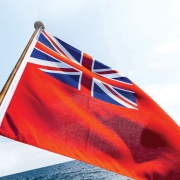
Yachting Consultants
Sale-Charter-Brokerage-Management
Headquarters:
34 Rue Caffarelli 06000 Nice, France
Front Office:
Boulevard de La Croisette – Port Canto 06400 Cannes, France
T.: +33 493 43 82 83 Email: [email protected] Website: www.alliedyachting.com

Yacht classifications, also referred to as classification societies or class societies the that rules are an integral element of owning a yacht and an important part of maritime safety. These classifications dictate the design, construction and ongoing maintenance of large commercial vessels and superyachts.
The classifications provide highly detailed and technical standards which cover the yacht’s hull, its engines, and key safety systems. Naturally technology is constantly advancing and so new safety features and procedures are frequently evolving to cater for this.

Standard Yacht Types
Yachts are typically segmented based on overall length and how many passengers they can accommodate. The standard yacht classification types are large yachts, sailing yachts, commercial yachts and private yachts.
Commercial yachts are those yachts which engage in commercial activities, i.e charter yachts. These yachts do not transport or carry any cargo and can carry no more than 12 passengers when underway. In contrast, private yachts are typical pleasure vessels used solely for recreational or leisure purposes.
Classification society
Classification societies are organizations which ‘set the rules’ that govern the construction, maintenance, and operation of yachts and vessels. Currently, there are a total of 12 members of the International Association of Classification Societies, of which the main societies involved with yachting are::
- ABS (American Bureau of Shipping)
- Bureau Veritas
- Lloyds Register
- RINA (Royal Institution of Naval Architects)
Classification societies were first started when insurance underwriters Lloyds of London set standards for the ships that they would ensure.
What is a flag state?
A vessel’s flag state is the jurisdiction or nationality under whose laws the vessel is registered or licensed.
The flag state has the authority and the responsibility to create regulations for vessels registered under its flag. These typically involve those relating to the inspection, certification, and issuance of safety and pollution prevention documents for the vessel.
Different flag states may perform inspections on the safety aspects of yachts using their own inspectors or use classification societies or other recognised organization to perform these inspections.
I have written a separate blog post which goes into further detail on Flag States and the importance of choosing the right flag for your yacht.

What is the classification process?
The first step of classification involves the assessment of a yachts design and regular inspections during the construction or conversion of a yacht. Once it is confirmed that all standards have been met, a certificate of classification is issued.
The certificate details the standard met, the intended use for the vessel, and whether the vessel should be used only in sheltered waters. The certificate is aevidence evidence that the yacht has been built too and meets industry standards.
In order to maintain classification regular surveys of the yacht are required. These surveys typically take place every 5 years. These surveys assess things such as the thickness of the hull, possible fractures, and other potential damage. They also consider the condition of electrical systems, machinery and equipment.
Mandatory Classification Certificates
There are a variety of different classification certificates. The number and type of mandatory certificates for a given yacht will depend on its size.
International Tonnage Certificate
This expresses the internal volumes of the yacht in gross tonnes. Unlike displacement tonnage, this does not quantify the weight of a vessel.
Large Yacht Code Certificate
This certificate covers navigational and signaling equipment, life saving appliances, fire protection, means of escape, and manning and crew accommodation. `
Class Certificate
This mainly deals with the yacht’s hull, machinery, electrical equipment, and outfitting.
International load line certificate
This certificate covers the weather tightness of the yacht
Safety Radio Certificate
This certificate only applies if the yacht’s gross tonnage exceeds 300GT. It covers radio communication and distress installations.
MARPOL Annex I Certificate
This certificate only applies if gross tonnage exceeds 400GT and covers the disposal of oil and bilge water
MARPOL Annex IV Certificate
This certificate only applies if gross tonnage exceeds 400GT or if the yacht is certified to carry more than 15 people and covers the disposal of sewage from ships
Marpol Annex V
This certificate covers the disposal of rubbish and applies to all ships
Marpol Annex VI
This is applicable if gross tonnage exceeds 400GT as well as to all main and auxiliary engines with a power exceeding 130kW. It concerns the emissions from mains and auxiliary engines (NOx and SOx). Safety Construction and Safety Equipment
These cover machinery, electrical parts, life saving and navigational equipment for yachts with a gross tonnage above 500GT. International Safety Management Certificate
This only applies to yachts with a gross tonnage greater than 500GT. A certified management company is requested to carry out this service, preparing operational manuals, procedures for drills, and taking care of the maintenance of the yacht and its installations. International Ship and Port Security Certificate
This only applies to yachts and ships with a gross tonnage greater than 500GT and covers the anti piracy certification. A certified management company is requested to provide ashore assistance and establish onboard procedures and operational manuals.
S A LT Superyachts – Your Trusted Partner For Your Superyacht Journey. Offering you an unbiased and comprehensive yacht charter and yacht sales consultancy. www.salt-superyachts.com
+44 2038 821 364
Share this post with your friends
Enquire now.
- THE PRINCESS PASSPORT
- Email Newsletter
- Yacht Walkthroughs
- Destinations
- Electronics
- Boating Safety
- Ultimate Boating Giveaway

- Uncategorized
Yacht Classifications
- By Dudley Dawson
- Updated: July 17, 2009
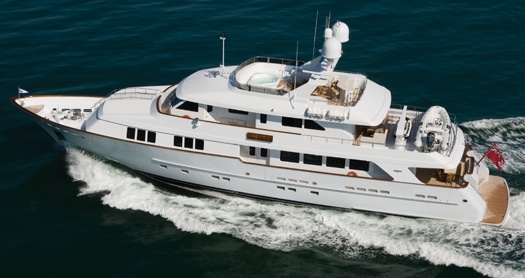
ytgjul17perf525.jpg
Let’s take a peek into the dark back corner of a London pub a couple hundred years ago, when Britain was the unquestioned ruler of the sea, as a group of Lloyd’s of London insurance underwriters licked their financial wounds from the latest loss of a cargo ship to Davy Jones’s locker. They’d had enough, and proposed to form an independent society to make ships safer by developing standards for construction, operation, and maintenance. Thus was born Lloyd’s Register of Shipping, no longer affiliated with Lloyd’s of London, but still the granddaddy of maritime classification societies.
The concept was so successful in improving safety and cutting losses that spinoffs and imitators soon appeared in other seagoing nations. There are now ten full members and one associate member of the International Association of Classification Societies ( www.iacs.org.uk ). Not all of them class yachts, and of those who do, not all class smaller yachts. The American Bureau of Shipping (ABS), for instance, does not class yachts under 24 meters, or about 79 feet, in overall length.
Each society also has different sets of rules and guides, several of which will be applicable to any given yacht. While national codes, such as the U.S. Coast Guard regulations, and international treaties, such as SOLAS, are mandatory, classification is in most cases voluntary. A shipowner or yachtowner elects to have his vessel classed in order to better assure a certain level of sound design and construction, and consequently, to reduce insurance premiums and losses.
Although there are differences in the details, the societies have much in common. Each issues written rulebooks and guides for use by designers, reviews and approves the vessel plans in advance of construction, and employs dedicated surveyors to assure that the vessel is built in accordance with the plans. There are also periodic inspections by this same corps of surveyors throughout the vessel’s service life to check that it is being maintained to the required standards.
The voluntary nature of classification creates a number of possibilities for a yacht owner. He can pick and choose from the several classification societies that cater to yachts. For instance, an American owner having a fast yacht built in Holland could choose to have it classed by the Norwegian society, DNV (Det Norske Veritas). This is where those detail differences come in, as some designers consider the DNV construction rules for high-speed vessels to be more realistic than those drafted by some other societies. Such shopping for classification is commonplace, and that’s why you’ll find surveyors for each society in each shipbuilding nation. In an Italian yard, for instance, you might find an ABS surveyor working on one vessel and a Lloyd’s inspector working on another, alongside the first. In some cases, where the surveyors are independent, or “non-exclusive” in society parlance, you might find him wearing a DNV jumpsuit one day and ABS coveralls the next.
In addition to choosing his classification society, an owner can choose the level of involvement he wants with classification. Full classification means plan approval before construction, inspection and approval of both construction and installed equipment (anchors, engines, generators, etc.), and periodic inspections and required maintenance after delivery. An owner can also add various options, including most recently, an environmentally based endorsement of the yacht as “green.”
All of this comes at a price, of course, both in meeting the initial requirements and in continuing costs. Some owners view any financial outlay as justified in protecting their vessel and those aboard; others elect to have the yacht designed and built to class, and then drop the class designation when fees and mandated maintenance expenses begin to exceed the savings in insurance premiums.
Finally, an owner can opt to have his designer and builder use the written classification standards as a guide in the construction of his new vessel, without actually contracting with the society. This avoids some of the expenses of questionable value, such as factory testing and equipment certification. Then an independent non-society surveyor or project manager can oversee the construction up to delivery, and the captain, vessel management firm, or favorite boatyard can track maintenance requirements. It’s not official, but it’s still classy.
- More Uncategorized

BoatUS Launches Online Advocacy Tool

Dock Danger

A Dream Fulfilled

3 America’s Cup Hashtags to Follow

Holterman Shipyard Debuts Xtreme X-65

For Sale: 2014 Sabre 42 Salon Express

Unveiling the Tiara Yachts EX 54: A Comprehensive Review

Performance Meets Luxury: Pershing 7X For Sale

- Digital Edition
- Customer Service
- Privacy Policy
- Terms of Use
- Email Newsletters
- Cruising World
- Sailing World
- Salt Water Sportsman
- Sport Fishing
- Wakeboarding
- Seller Market Analysis
- Trade Your Yacht
- Sold Yachts
- We Buy Boats
- Exclusive Listings
- Yachts for Sale
- New Yacht Builds
- Nautor Swan Yachts
- Sichterman Yachts
- Luxury Yacht Charters
- Search Charter Yachts
- Charter Management
- Luxury Events
- Team Members
- Boat Show Events
- North Report Magazine
- Testimonials
- +1.954.900.9988
Blog | Owner’s Guide to Yacht Classification
Yacht classification is a system used to categorize yachts based on various factors such as size, construction, and intended use. The specific classification categories and requirements can vary between different yacht classification societies, but some common classifications include:
- Pleasure Yacht: A yacht intended for leisure use, typically not engaged in commerce.
- Charter Yacht: A yacht that is available for hire for pleasure use, also known as commercial yacht.
- Large Yacht: A yacht that exceeds a certain size or gross tonnage.
- Small Commercial Yacht: A yacht that is used for commercial purposes but does not exceed a certain size or gross tonnage.
- Passenger Yacht: A yacht that is used to carry passengers for hire.
- Workboat: A yacht or vessel intended for work-related use, such as a survey vessel, cable layer, or other specialty use.
- Ocean Going: Yachts that are able to make ocean passages and are built and equipped to meet the requirement of such voyages
- Coastal: Yachts that are intended to operate in coastal and sheltered waters and meeting less stringent requirement than ocean going yachts.
The main differences between yacht classification societies are their specific rules, regulations, and requirements for yacht classification. While many societies have similar overall goals of ensuring that yachts meet certain standards of design, construction, and maintenance, they may have slightly different interpretations of these standards and how they should be applied.
Some societies may have stricter or more detailed rules and regulations than others. For example, one society may have more stringent requirements for fire protection, while another society may place more emphasis on stability calculations.
Another difference is the type of yachts they cover and the services they offer. Some societies focus primarily on pleasure yachts, while others also cover commercial yachts and workboats. Societies may also offer different levels of classification, such as “unrestricted” or “restricted” class, and this might vary depending on the intended use of the yacht.
Lastly, some societies have a more global presence than others, or have more experience or expertise in certain types of yachts or regions. This can be important for yacht owners who plan to take their vessel to different parts of the world and may need to comply with different regulations in different countries.
In short, yacht classification societies are similar in their overall goals, but they can have different rules, regulations, and requirements for yacht classification, different services and different areas of focus. Yacht owners should research and compare different societies to determine which one is the best fit for their specific needs and intended use of the yacht.
There are several yacht classification societies that provide certification and inspection services for yachts and other small vessels. Some of the most well-known include:
- American Bureau of Shipping (ABS)
- Bureau Veritas (BV)
- Germanischer Lloyd (GL)
- Lloyd’s Register (LR)
- RINA (Registro Italiano Navale)
- Det Norske Veritas (DNV) now known as DNV GL
These organizations are responsible for ensuring that yachts and other vessels meet certain standards of design, construction, and maintenance, and they issue certificates of compliance to vessels that meet these standards. They also conduct periodic inspections to ensure that vessels continue to meet these standards over time. Some of them also provide additional services such as collision avoidance, navigation and stability calculations and other specialized services.
Recent Stories
Swan arrow: nautor swan’s power yacht division latest masterpiece set to debut at cannes yachting festival, why now is the perfect time to book your yacht charter for the holidays.

Talk to us Contact Our Team
I understand that by signing up I agree with 26 North’s Privacy Policy .
Welcome aboard!
We have added you to the newsletter.
We have received your information and an agent will get back to you ASAP
Sign up for Yoga On the Docks Tuesdays at 8 AM
We have received your registration. See you on the docks!
Marine & Offshore
News Bureau Veritas partners with Tara Ocean Foundation to class polar station
Ensuring comfort, safety and sustainability
Yacht owners, charterers and passengers increasingly expect both top-notch comfort and green credentials from their yacht or from the commercial vessel they charter. While luxury remains at the core of the yacht business, ship owners, operators and charterers must meet port requirements and national regulations for limited emissions. Bureau Veritas offers key technical, regulatory and environmental expertise to enable yachts to continue sailing in protected areas while maintaining high levels of luxury and comfort. Our notations, digital tools, global network, and expertise with super and mega yachts provide a safe and eco-friendly onboard experience.
Enabling regulatory compliance
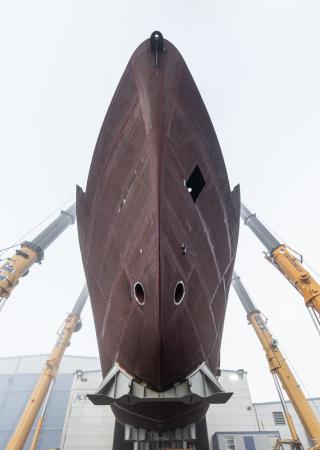
It is crucial for yachts to comply with safety and technical regulations for ship design, structure and maintenance. Bureau Veritas’ NR 500 Rules for the classification and certification of yachts under 100 meters [1] outline detailed requirements for building materials, hull structure, machinery, automation and more. Find out more about our Rules & Notations for Yachts
[1] Larger yachts must follow class rules for sea-going vessels, and according to the chosen Flag specific yacht codes, for example the Red Ensign Yacht Code.
Improving ship sustainability
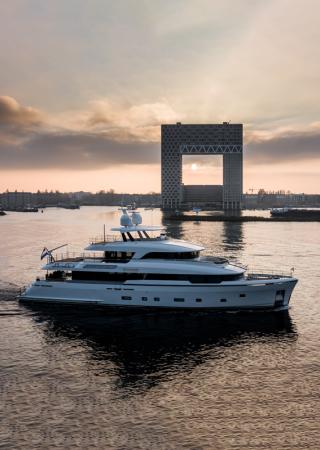
To meet changing social and regulatory expectations, yacht owners are increasingly exploring greener shipbuilding and operating practices. Bureau Veritas’ Green notation verifies that yachts have been optimized for energy efficiency, assessing fuel consumption, ship super structure and hull design. Yachts that currently limit their emissions by using hybrid electric power can also earn a Hybrid notation. Those designed to someday use hybrid electric power can earn a Hybrid-Prepared notation
Energy storage systems (ESS) are also an option for yacht owners to reduce emissions while in port and when operating in sensible eco-areas. Those systems also help reduce fuel consumption. Our rules, notations and technical expertise ensure for safe and efficient ESS design and installation. Although our current fuel cell guidelines apply to commercial shipping, Bureau Veritas’ experience in this technology may be of use to owners and yards exploring greener means of energy production and propulsion.
Increasing onboard comfort and wellbeing
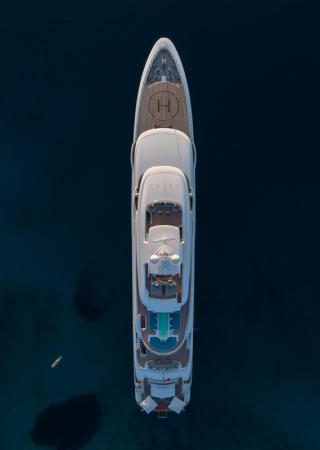
Comfort is a non-negotiable element for yacht owners and passengers, and this means ensuring limited onboard noise and vibrations. Yachts can earn Bureau Veritas’ Comfort notation by undergoing an assessment of sources of noise and vibration, such as engines and propellers. Owners and yards can then take measures to improve ship structure and design, reducing noise and increasing comfort. Bureau Veritas has also partnered with owners and operators to establish better bio-risk management. This includes outbreak management plans, embarkation and debarkation plans, protective measures and other health best practices to safeguard the wellbeing of all passengers and crew.
Digital tools for yachts

Digitalization is changing how ship owners expect their vessels to be designed, built, assessed and classed. Bureau Veritas offers a range of digital tools to help yacht owners quickly and accurately conduct classification, assess safety and manage their fleets. These include Veristar Project Management , Digital Classification and remote surveys , and our ComposeIT and StarBoat structural assessment tools. Increased digitalization naturally increases cyber security concerns. Bureau Veritas’ CYBER SECURE notation helps owners comply with IMO legislation (Resolution MSC.428 (98)).
A global network of experts
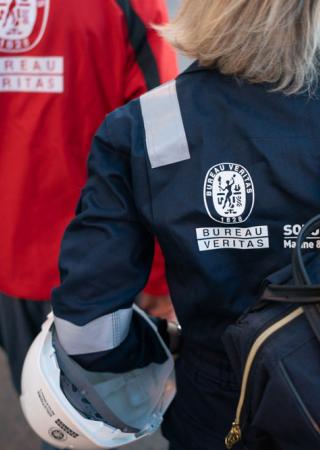
The yacht market is global, with specialist shipyards scattered around the world. Bureau Veritas’ extensive network of experts is available worldwide to provide classification, surveys and support for yachts. Learn more about our profile
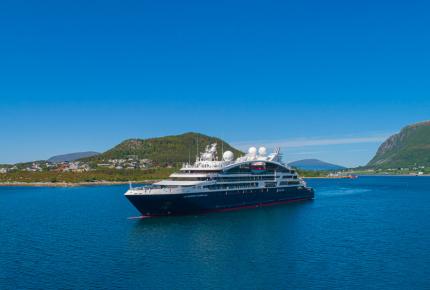
Cruise Ships
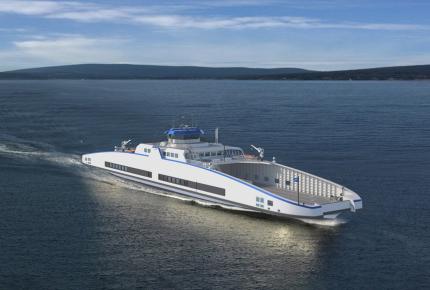
Passenger Ships - Ferries
Your toolbox.

Rules & Guidelines
Bureau Veritas develops rules and guidance notes.

Comply with regulatory requirements and optimize your unit’s design with our software programs.

Veristar Info
Log in to your portal and monitor the status of your fleet.

Approval Explorer
Identify, locate and contact approved service suppliers and manufacturers.

Training solutions
Discover our training offer for all businesses.

Class & Statutory News
Get the most recent Class & Statutory information.

Flag authorizations
Display the list of Flag Authorities and delegations granted to Bureau Veritas.

Easily locate Bureau Veritas classed ships with our on-line register.

Research & Development
Read about our main R&D projects and publications.

IMO amendments
Navigating statutory requirements

Digital Yacht at Newport International Boat Show 2024

ePropulsion electric engine monitoring on EngineLINK

Digital Yacht at Sydney Boat Show 2024


Webinar on 4G and 5G Internet routers for your boat.

White Paper on New Class B “SOTDMA” technology
Many people are unaware of the recent approval of a new AIS Class B “SOTDMA” technology that sits nicely between the two existing Class A and Class B technologies.
Clear online information about Class B “SOTDMA” still seems to be in short supply, so we have produced a White Paper on this new “Class B+” technology, highlighting its benefits, how it compares to Class A and Class B and what types of boats and applications should consider installing this new generation of Class B+ transponders.
A full copy of the White Paper can be downloaded by clicking here .
1 – Background
AIS (Automatic Identification System) is now one of the most widely used and significant navigation safety technologies since the introduction of radar. The system was originally developed as a collision avoidance tool to enable commercial vessels to ‘see’ each other more clearly in all conditions and improve the helmsman’s information about his surrounding environment.

AIS does this by continuously transmitting a vessels identity, position, speed and course along with other relevant information to all other AIS equipped vessels within range. Combined with a shore station, this system also offers port authorities and maritime safety bodies the ability to manage maritime traffic and reduce the hazards of marine navigation.
Due to the great safety benefits offered by AIS, the fitting of a Class A transponder was made compulsory throughout the world in 2002 for all vessels over 300 gross tonnes or that carried more than 12 passengers. For smaller vessels that fell outside of the mandate, a Class B transponder was defined which allowed fishing and leisure vessels to fit a lower power/cost transponder that worked on the same AIS network and could receive and transmit signals to the Class A transponders fitted to commercial vessels.
AIS transponders are now commonly seen on many leisure vessels and with the approval of personal AIS SARTs for use as Man Overboard systems, in conjunction with Search and Rescue vessels/helicopters now fitting SAR transponders, AIS is becoming an important part of the Global Maritime Distress and Safety System (GMDSS).
Another new AIS application is vessel tracking, with websites like Marine Traffic and AISLive that collect and display thousands of AIS targets from their shore based AIS reception networks, and global satellite reception via companies such as Orbcomm , exactEarth and Spacequest .
Many national marine authorities are installing special Aids to Navigation (AtoN) transponders that can replace traditional Buoys and Beacons and transmit local weather/tidal information to passing vessels, while some large and busy harbours or shipping areas use AIS as part of their Vessel Traffic Services (VTS) to manage and control shipping movements.
It is this continuous expansion of the global AIS network, that has led to the approval of a new Class B technology that sits half way between the original Class B technology and the Class A technology found on commercial shipping. This new technology does not supersede or replace the original Class B transponders, but it does offer significant improvements for some types of vessels and applications. For the purposes of this White Paper, we will refer to this new technology as Class B+.
2 – How AIS Works
To fully appreciate the benefits of this new Class B+ technology, it is necessary to understand how AIS works.
An AIS transponder consists of a GPS receiver and a VHF “Data” Radio. The transponder takes its GPS position and transmits this in Digital Form on two VHF channels dedicated to AIS (161.975MHz and 162.025MHz).
In order that multiple AIS transponders can “play nicely together” and avoid all of the devices transmitting at the same time, causing interference and loss of data, AIS transponders use a system called Time Division Multiple Access (TDMA). This is a similar system to that used in mobile phones, where each AIS transponder claims a very short 26.6 millisecond “time slot” where it transmits its information. The claiming of Class A time slots uses “Self Organised” TDMA where multiple transponders know how to claim and reserve time slots and what to do if there is a dispute with another transponder trying to claim the same time slot.
The system works well and allows up to 4500 ships to work within close proximity of one another, automatically giving priority based on distance apart, i.e. as the number of vessels increases, the ones furthest away do not get a time slot.
When Class B transponders were introduced, they used a slightly different technology called “Carrier Sense” TDMA where the Class B transponder listens to the Class A transponders and as soon as it detects an empty time slot, grabs it and makes its transmission. Occasionally a Class A transponder will “steal” a time slot from a Class B transponder and the system is designed that Class A transponders always take priority over Class B, so the Class B transponder will have to delay its transmission and start listening again for another empty slot.
The number of transmissions that a transponder makes and the type of data it sends varies, based on its Class (A or B), its speed, whether it is manoeuvring and its navigation status. The Class A transponder of a fast-moving ferry may output its position every couple of seconds while a Class B equipped pleasure vessel will only transmit every 30 seconds, whilst underway.
As previously mentioned, the AIS data is transmitted over two channels of the VHF frequency range and a Class A transponder transmits at 12.5 Watts while an original Class B transponder only transmits at 2 Watts which – to put this in to perspective – is a third of the power of a hand-held VHF that transmits at 6 Watts.
This 2 Watt transmit power restricts Class B transmissions to an absolute maximum range of about 8-10 Nautical Miles and also means that traditional Class B transmissions are often not received by the AIS Satellites that provide global vessel tracking.
3 – The New Class B+ Technology
The new Class B+, often referred to as “Class B SOTDMA” or “Class B 5W”, has been defined to bridge the gap between Class A and Class B transponders, offering some clear advantages for some types of vessels and applications.
Class B+ uses the same SOTDMA technology as Class A and therefore has the same priority when it comes to reserving a time slot, guaranteeing that it will always be able to transmit, even in busy AIS congested waters. For fast moving vessels this is important as a missed transmission can result in a vessel moving a long distance before it next manages to send a transmission.
Another feature that the new Class B+ technology it has taken from Class A, is the increased and automatic changing of transmission rates depending upon speed. Unlike Class A, the update rate is unaffected by whether the vessel is manoeuvring, but as the vessels speed increases, the number of transmissions increases so that other vessels get a clearer and more up to date view of where the boat is.
For slow moving vessels the increased update rates of Class B+ are not so important, but a fast power boat travelling at say 23 knots, will move 360 meters in 30 seconds, which is the update rate of a normal Class B transponder. On a Class B+ vessel travelling at 23 knots or more, the update rate is 5 seconds, so (using the above example) only 60 meters would be moved between updates.
Finally, Class B+ transponders have a higher power transmission 5 Watts instead of 2 Watts and this not only increases the range over which the vessel’s transmission will be received, assuming good antenna height and performance, but it also significantly improves the AIS Satellite reception, enabling global tracking.
4 – Comparison of AIS Classes
The following tables have been created to provide a “side by side” comparison of the three different classes of AIS.
Class A, B and B+ Functionality
| 12.5W | 5W | 2W | |
| Up to every 2-3 secs | Up to every 5 secs | Every 30 secs | |
| YES | NO | NO | |
| SOTDMA | SOTDMA | CSTDMA | |
| YES | YES | NO | |
| YES | NO | NO | |
| YES | NO | NO | |
| £2000 | £650 | £500 |
As can be seen from the table above, in normal operation a Class A transponder transmits at a much higher power than a Class B. In “real-life” terms a well installed Class B transponder should be able to transmit up to 7-8NMs whilst a Class A transponder maybe seen as far as 20-25NMs away. With its 5W output, a Class B+ will be better than a Class B (2W), but not x2.5 better, typically 10-12NM should be seen.
As illustrated in the following table, Class B and B+ transmit the same data, a sub-set of the data transmitted by a Class A transponder.
Class A, B and B+ Transmitted Data
| YES | YES | |
| YES | YES | |
| YES | YES | |
| YES | NO | |
| YES | NO | |
| YES | NO | |
| YES | YES | |
| YES | YES | |
| YES | NO |
Finally, the table below shows the different data transmit rates of the three systems. As can be seen, Class A transponders have several different transmit rates, based on speed, manoeuvring and Nav Status, whereas the Class B+ transmission rate is purely based on speed.
Comparing Class B+ to the original Class B, it can be seen that the simple two update rate (underway or stationary) of the original Class B has been expanded and increased in Class B+. For any boat that regularly travels at over 15 knots and particularly for boats capable of travelling at over 23 knots, the increased transmission rates offered by Class B+ are an important benefit.
Class A, B and B+ Transmit Rates
| 3 mins | 3 mins | 3 mins | |
| 10 secs | 3 mins | 3 mins | |
| 10 secs | 30 secs | 30 secs | |
| 3.3 secs | 30 secs | 30 secs | |
| 6 secs | 15 secs | 30 secs | |
| 2 secs | 15 secs | 30 secs | |
| 2 secs | 5 secs | 30 secs | |
| 6 mins | 6 mins | 6 mins |
5 – Useful Links
If this White Paper has encouraged you to learn more about AIS or even purchase an AIS system for your boat, then the links below should be of interest…
- Digital Yacht’s website where you can find the latest information on our AIS products.
- All About AIS website for more information on AIS systems
- Wikipedia article on AIS
- IMO website that details the global carriage requirements of AIS
- US Coast Guards website on AIS
- Maritime Traffic website leading online AIS website
Related media
Download our media resources
- ais transponder
- New technology
- White Paper
Share this article
Next generation navigation app presentations at paris boat show 2018, signal k server v1.10.0 now supports ikonvert gateway, comments 10.
B+ is an interesting development in AIS for small craft but raises a few questions: 1/ Are these transmissions backward compatible with older AIS receivers eg: they do not show up small craft as large ships , 2/ If a large ship filters out class B does that include B+, 3/ If there is a lot of class A traffic, does the B+ traffic have a lower priority, ie: the faster update rate is a target and not necessarily guaranteed, 4/ Assuming enough processing power is available, could some existing class B transceivers be software upgraded ( not the power output ) to support class B+ or is the requirement that B+ must be at 5W, 5/ with 4dB more power and more frequent transmissions B+ transceivers are presumably more power hungry, how much extra is this in practical terms ?
Hi Dean, Some really good questions which I will try and answer: 1) All Class B+ transmissions are backward compatible and will be received by all Class A, traditional Class B and AIS receivers. Also Class B+ equipped vessels will not appear as large ships just because they use the same SOTDMA technology – Class B+ uses the same boat categories as Class B i.e. Pleasure Craft, Sailing Craft, Fishing, etc. 2) Class B and Class B+ are seen as being the same type of AIS transmission and although they will always be received by the Class A transponders on large vessels, in theory they could be “filtered out” or not displayed on a large vessel ECDIS (chart plotter). 3) Class B+ has the same priority as Class A and will take priority over a traditional Class B in busy shipping areas. 4) As far as I am aware no Class B units can be software upgraded to Class B+ but Digital Yacht will soon be announcing a cost effective upgrade path to Class B+ for their existing Class B transponder owners. 5) In reality, due to the very short transmissions (26mS) Class B and Class B+ transponders have pretty much the same power consumption (around 0.25A at 12v)
Will the Digital AIT 5000 (B+) display AIS targets & information on my Garmin 7200 chart displays?
Yes the good news is that our latest AIT5000 and AIT25000 Class B+ transponders will work with all AIS compatible chart plotters either via NMEA0183 or NMEA2000, depending upon what interface(s) the chart plotter has. There is no change in the way a Class B+ transponder interfaces to other equipment, it is just the underlying AIS transmission technology that has changed.
Best regards PAUL
Shouldn’t the chart showing the difference in “Class A, B and B+ Transmitted Data” indicate Class A vessels transmit “ETA + Destination + Draught NO NO” be corrected to show YES NO.
Well spotted, glad to see someone has accurately read our White Paper and you are 100% right.
I have corrected and updated the White Paper to V1.01.
Thank you for your feedback.
The AIT5000 kit includes a external GPS Antenna. 1. Is this GPS antenna required when boat already has a external GPS antenna connected to chart plotter via NMEA2000 ? Regards John
I am afraid that all Class B(+) AIS Transponders must have their own GPS receiver and antenna. This was stipulated in the International Class B AIS Transponder specification, to ensure that all transponders can work autonomously, with no reliance on other equipment that may fail or be turned off.
The latest AIT5000 has a very sensitive GNSS receiver and many dealers mount the antenna below deck on GRP hulled boats. As long as it is mounted vertically with just fibre-glass above it, you should get good performance and can use the GNSS Status page of proAIS2 to check reception before bolting everything down in their final resting place.
I’m a sailor and tipicaly the boatspeed in good windconditions is 6 -7 knt. In that case I don’t see a difference between class B and B+. Is this correct? The article is focused on the advantage of class B+ for fast traveling leisure boats, but I wonder what about the visibility of low speed vessels. Is it a risk that fast moving vessels don’t see slow moving vessels in time due to the fact that the signal of a class B transponder has a lower priority than class A and B+? If that is true is the installation of a class B+ transponder on slow moving vessels an advantage for the visibility on fast moving vessels?
Best regards, Johan Snijders
For a slower moving yacht, you are correct, there is less benefit in having a Class B+ compared to the original Class B, but the extra power 5W versus 2W should give you better transmit range (typically an additional 2-3 NMs) and the SOTDMA technology will ensure that you are always getting a transmission slot even when surrounded by hundreds of AIS equipped vessels.
A slow moving yacht with Class B+ is transmitting at the same rate as a normal Class B and I think there would have to be an awful lot of AIS equipped vessels in the area and transmission slots in very limited supply, before the normal Class B became noticeably less visible to fast moving vessels.
That said, the number of AIS transponder equipped vessels is only going to increase and it might be worth investing in Class B+ to be sure that you get the best future performance.
Comments are closed.
Webinar on Digital Yacht AIS Transponder Range

Webinar on Net Protect – NMEA2000 Cyber Security Tool

- New Sailboats
- Sailboats 21-30ft
- Sailboats 31-35ft
- Sailboats 36-40ft
- Sailboats Over 40ft
- Sailboats Under 21feet
- used_sailboats
- Apps and Computer Programs
- Communications
- Fishfinders
- Handheld Electronics
- Plotters MFDS Rradar
- Wind, Speed & Depth Instruments
- Anchoring Mooring
- Running Rigging
- Sails Canvas
- Standing Rigging
- Diesel Engines
- Off Grid Energy
- Cleaning Waxing
- DIY Projects
- Repair, Tools & Materials
- Spare Parts
- Tools & Gadgets
- Cabin Comfort
- Ventilation
- Footwear Apparel
- Foul Weather Gear
- Mailport & PS Advisor
- Inside Practical Sailor Blog
- Activate My Web Access
- Reset Password
- Customer Service

- Free Newsletter

Catalina 270 vs. The Beneteau First 265 Used Boat Match-Up

Ericson 41 Used Boat Review

Mason 33 Used Boat Review

Beneteau 311, Catalina 310 and Hunter 326 Used Boat Comparison

Tips From A First “Sail” on the ICW

Tillerpilot Tips and Safety Cautions

Best Crimpers and Strippers for Fixing Marine Electrical Connectors

Thinking Through a Solar Power Installation

Polyester vs. Nylon Rode

Getting the Most Out of Older Sails

How (Not) to Tie Your Boat to a Dock

Stopping Mainsheet Twist

Fuel Lift Pump: Easy DIY Diesel Fuel System Diagnostic and Repair

Ensuring Safe Shorepower

Sinking? Check Your Stuffing Box

The Rain Catcher’s Guide

What Do You Do With Old Fiberglass Boats?

Boat Repairs for the Technically Illiterate

Boat Maintenance for the Technically Illiterate: Part 1

Whats the Best Way to Restore Clear Plastic Windows?

Giving Bugs the Big Goodbye

Galley Gadgets for the Cruising Sailor

Those Extras you Don’t Need But Love to Have

What’s the Best Sunscreen?

UV Clothing: Is It Worth the Hype?

Preparing Yourself for Solo Sailing

How to Select Crew for a Passage or Delivery

R. Tucker Thompson Tall Ship Youth Voyage

On Watch: This 60-Year-Old Hinckley Pilot 35 is Also a Working…

On Watch: America’s Cup

On Watch: All Eyes on Europe Sail Racing

Dear Readers
- Marine Electronics
- Safety & Seamanship
Comparing Class B AIS Transceivers
Icom vs. vesper: which ais-b transponder is best for cruisers.
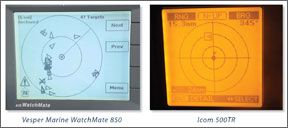
The popularity of Automatic Identification Systems (AIS) has grown exponentially in recent years, particularly among small- to mid-sized cruising sailboats. Lower costs have played a big hand in this, as has increased participation (the more boats with AIS, the more boats there are to see); however, the primary driver remains boat owners looking to increase safety.
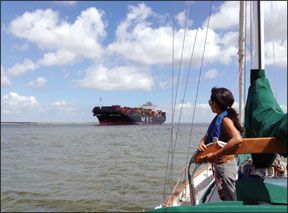
Photo by Frank Lanier
AIS transceivers help skippers navigate high-traffic areas by painting an overview of marine traffic and providing important information about nearby commercial ships and other vessels that are AIS-equipped. AIS is a seemingly simple system that transmits dynamic information about a vessels speed, course, and position plus static information including the vessels name, call sign, and Mobile Maritime Service Identity (MMSI) number over marine VHF frequencies.
AIS transceivers are split into Class A (commercial) and Class B (recreational), and they broadcast information from every 2 to 30 seconds. Class A transceivers have a maximum VHF power output of 12.5 watts, are required to broadcast more data than Class B units, and must update data more frequently than Class B. Class B transceivers are designed to provide a similar yet limited service, at a lower cost, to smaller vessels not required to carry a Class A unit. Class B units transmit less data at a slower rate using a 2-watt transmitter. AIS listen-only devices, like the Raymarine AIS250 and SI-TEX/Nasa Marine receiver we tested (March 2007), receive AIS broadcasts but do not transmit any information.
Class B transceivers relay vessel information, position data, course over ground, speed over ground, heading, status, and even offer a means of direct dialing another boat via VHF channels by utilizing a provided MMSI number and select VHF channels. For specifics on the AIS broadcast data types and frequencies, check out this article on www.practical-sailor.com.
While not a replacement for radar, AIS benefits from the propagation characteristics of VHF, allowing it to see around and behind objects such as large ships, small islands, rocks, etc.-assuming whatever is behind these objects is equipped with AIS.
AIS transceivers can be useful search-and-rescue tools. Like an activated EPIRB, they offer the Coast Guard and other rescue personnel the boats exact location and amplifying information. They also can be used to track the latest generation of AIS-based man-overboard beacons like those we reviewed in the May 2013 issue.
Our last look at AIS units was in September 2009, when we evaluated the Navico NAIS-300 and the West Marine AIS1000. Both were Class B devices capable of sending and receiving AIS data. Each relied on compatible chartplotters, multi-function displays, or PCs to display their information. The NAIS-300 received a Recommended rating, while the AIS1000 was named Budget Buy.
In our August 2010 issue, contributor Joe Minick reported the pros and cons of using an AIS receiver with a PC display as a collision tool while cruising near Turkeys Dardanelles Strait. Fast-forward three years (a lifetime in the world of electronics), and standalone AIS units with integral displays have come into their own, at comparable prices to the non-display units we tested previously.
What We Tested Our latest evaluation compared Class B transceivers from two key players in the AIS market. From Icom, a global company whose product line includes communications equipment and products based in the marine, avionics, land mobile, and wide-band receiver industries, we tested the MA-500TR. New Zealand-based Vesper Marine, a relatively new company that has steadily garnered a worldwide reputation for quality and innovation, submitted its WatchMate 850 for testing.
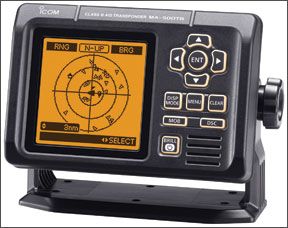
Photo courtesy of Icom
Both transponders will pick up signals from AIS-equipped search-and-rescue transponders (SARTs) or man-overboard (MOB) beacons, but how they display the signals may differ. The WatchMate 850 clearly explains that these distress signals are displayed with a special icon and an alarm will sound, but Icom does not address it in the MA-500TRs owners manual. We were unable to test this or to get confirmation from Icom, but its likely the SART icons appear like other AIS targets.
AIS transponders use GPS signals to get position data and VHF signals to send and receive other data. Of our test products, only the WatchMate 850 features an internal GPS antenna. The 500TR must be networked with a chartplotter to get position data. Neither of the tested AIS transponders comes standard with a VHF antenna, so users have two choices: Buy and install a dedicated VHF antenna for the AIS device or use a splitter to connect the transceiver to an existing VHF-radio antenna. Depending on the hardware, this latter option could potentially affect signal strength. Vesper Marine offers a specialized AIS/VHF splitter, the SP160, which the company claims has no signal-strength loss. (We recently tested the SP160 and will be reporting on it in an upcoming article.) Other companies like West Marine and Digital Yacht also market splitters designed for AIS connections, but we have not yet tested them.
For advice on where to mount an AIS-VHF antenna, click here .
How We Tested The Icom and Vesper Marine units went head-to-head in bench tests and field tests while cruising the waters of Hampton Roads, Va., an AIS-target hotspot with a steady stream of recreational, commercial, and military vessels.
The products were rated on AIS functions, control capabilities, user-interface, filtering capability, display quality, and screen visibility, both belowdecks and in bright sunlight. Other rating considerations included power consumption, networking ability, water resistance, ease of use, and installation requirements; price and warranty also were factored in final ratings.
Unlike VHF radios, transmitting on the AIS devices is automatic, low-wattage, and too fast for testers to effectively measure power output or consumption while transmitting, so we relied on manufacturer-provided measurements for these specs. (See Value Guide.)
Icom 500TR The MA-500TR (681) is a Class B AIS transponder designed for non-SOLAS vessels (non-commercial pleasure craft, work boats, and small vessels, etc). The 500TR receives dual AIS channels (87B and 88B) simultaneously and receives both Class A and Class B AIS information. Vessel information (boat MMSI, name, type, position, speed, course, etc.) is automatically transmitted at fixed intervals or under base station control.
The 500TR features a full dot-matrix display with adjustable backlight and contrast. It looks similar to a mini-radar display with north-up and course-up options, as well as display ranges from 0.125 nautical miles to 24 nautical miles.
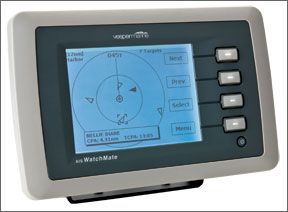
Photos by Frank Lanier and courtesy of Vesper Marine
The front of the 500TR has 11 pushbuttons that control various functions. These include a dedicated MOB button, an essential feature on chartplotters and handy feature on AIS units. Pressing the 500TRs MOB button drops a waypoint flag icon that you can steer back to. The power button serves double duty, also providing easy adjustment of display brilliance and contrast. All of the controls and their respective functions were fairly intuitive and straightforward.
Operationally, the 500TR has a number of collision-risk management functions, such as a list of local targets, as well as a danger list of targets you could potentially collide with. The Target list shows all detected AIS-equipped vessels and targets sorted by distance, from closest to farthest; this is updated every 5 seconds.
The Danger list shows all vessels within 6 nautical miles CPA (closest point of approach) and 60 minutes TCPA (time to CPA) from your vessel. These parameters are not user-adjustable; however, they can be sorted by CPA or TCPA. The CPA is user adjustable between 0.1 and 6 nautical miles, in 0.1 nautical miles increments, while the TCPA can be adjusted from 1 to 60 minutes, in 1-minute increments. Additionally, the Detail screen shows all available information about the selected AIS target (name, MMSI, etc).
As a target vessel enters the CPA / TCPA range, its displayed icon blinks and an alert beep is sounded; an external speaker can be added to make the collision alarm easier to hear when away from the unit.
The 500TRs compact size and waterproof rating (IPX7, or submersible to 3 feet for 30 minutes) mean it can be mounted at the helm, in the cockpit, or belowdecks at the nav station. Testers found the 500TR display easy to read belowdecks, in direct sunlight, and while wearing polarized sunglasses. Backlighting and contrast adjustments were easy to use and effective.
When connected to a compatible Icom VHF radio, the 500TR provides an easy means of making individual DSC calls to another boat without having to manually input MMSI numbers. Simply select a vessel using the cursor keys, then push the 500TRs DSC button.
Other 500TR features include the ability to store up to 100 waypoints in memory and to receive, display, and store DSC safety-related messages from Class A AIS transponders (up to 20 automatically stored in memory).
The back of the unit contains connectors for a GPS receiver, VHF antenna, power connections, and an NMEA plug. The 500TRs data output uses the NMEA 0183 format for easy connectivity to most current radars, chartplotters, and navigation systems. Theres also a cloning cable receptacle that allows users to connect the unit to a computer, conceivably creating a repeater display.
For troubleshooting and operational checks, the 500TR has a diagnostics page that allows you to check both monitor operation and transponder health.
Another useful feature is that the transmit function can be turned off, essentially converting the 500TR to a receive-only unit. This is done by pressing down the left and right arrow keys simultaneously until a transmit off message appears on the screen; to resume transmitting, simply reverse the process; we did not find directions for doing this in the owners manual.
The 500TR comes with an external GPS antenna, a NMEA connector cable, mounting bracket kit, and DC power cable.
Bottom line: The 500TR has a lot to offer, including a three-year warranty, but when compared to the WatchMate 850, its limited target-filtering ability and its external GPS antenna requirement held it back. But, its almost $100 less than its competitor (and costs less than some current display-less Class B transceivers), so it gets the Budget Buy pick.
Vesper Marine WatchMate 850 A driving philosophy behind the WatchMate 850 is the ability to reduce screen clutter by focusing on important targets. Target filtering is based on a user-selected combination of target speed, range, CPA, and TCPA, enabling users to reduce screen clutter by filtering targets that are moored, stationary, or moving away. Alarm and filter settings are grouped into profiles (harbor, coastal, offshore, etc.) and can be activated with a single selection. This allows you to pre-set set the various parameters to suit your preferences, then toggle between the groups as desired.
Targets are organized by collision-risk priority, with higher-risk targets at the top of the list, and can be stepped through in order of preference, as can the complete list of targets.
With great filtering options comes great responsibility to ensure targets of interest are not inadvertently filtered out by setting values too high (speed, for example) or too low (say, for range). Testers liked that the total number of targets tracked is always displayed, regardless of how aggressively you have them filtered. They also liked that when viewing a targets details, a press of the CPA button displays a plot showing the targets relative position to your vessel, at the time of their closest point of approach. This allows users to see whether a crossing target will pass ahead or astern. While the 500TR displays the CPA of a selected target, the WatchMate 850 actually advises you on whether to turn port or starboard to avoid a potential collision.
Unlike the Icom, the WatchMate 850 features an internal GPS receiver and GPS patch antenna, which greatly simplifies installations with a clear view of the sky; an optional externally mounted GPS antenna can be purchased for belowdeck installations. Testers marveled at the compact size of the WatchMate external GPS antenna, especially compared to the 500TRs GPS antenna.
Another useful tool is the anchor watch feature. Using heading information, the WatchMate 850 determines the location of the bow when dropping the hook, providing greater accuracy than just using the position of the GPS antenna (which is typically located at the stern). Theres also a screen that lets you fine-tune the physical location of the GPS antenna, providing even greater accuracy.
The WatchMate 850 can broadcast and receive safety and emergency messages to and from all AIS-equipped vessels within VHF range. It can also be placed in silent mode, which keeps the AIS and GPS receivers operating normally but switches off the automatic transmission of your vessels position and details, rendering the device a listen-only unit.
Like the 500TR, the 850 can initiate direct DSC calls to a target when connected to a compatible VHF radio without the need to manually enter MMSI numbers. Its USB connection also means it can easily be connected to onboard computers, providing both GPS and AIS data to any PC charting application.

Testers liked the AIS Status screen, which provides a host of information that can be used to verify proper operation or while troubleshooting. Additionally, the WatchMate 850 continuously monitors its transceiver performance, and if a problem is detected, an error alert pops up on the display and an audible alarm sounds.
The WatchMate 850 does not have a dedicated MOB or waypoint-entry button; in fact, there is no mention of any waypoint or MOB entry features in the owners manual. Its a feature we liked on the 500TR, and one that would be a good addition to the WatchMate, in our opinion.
The 850 is advertised as being compatible with all AIS search and rescue / MOB devices. If an AIS-SART or AIS-MOB is triggered, the WatchMate 850 sounds an alarm, displays a special icon, and provides continuous position updates as well as bearing and range to the SART or MOB. It can also be configured to activate an external alarm, buzzer, or other indicator.
The WatchMate has four control buttons and a power button. The control buttons grant access to a soft-key user interface designed to provide faster access to functions with fewer button pushes than a traditional menu-driven interface.
The fear with any piece of gear combining numerous functions with few control buttons is that operation beyond the basics may not be particularly intuitive. Testers were pleasantly surprised at how easy it was navigate the WatchMates menus without reaching for the manual, even when drilling down to the more advanced functions.
The rear of the WatchMate 850 has plugs for connection to an external GPS, VHF antenna, NMEA input/output connections, and a waterproof USB connector-the latter two allow you to integrate the AIS data into chartplotters or computer-based tracking systems respectively.
The WatchMate 850 features an easily viewable, grayscale, LCD display with adjustable backlighting and contrast, and a display range from 0.25 nautical miles to 48 nautical miles. Its screen is significantly larger than the 500TR. Even though some screen area is taken up by the soft keys (displayed along the right side), theres still a lot of dedicated display area remaining for a unit of this size. Testers found the display easy to read in al lighting conditions.
The WatchMate 850 is rated IPX7 like the 500TR, so it too is a good candidate for below- or above-deck installations. The package includes a protective cover, bracket and flush mount hardware, USB data cable, and a CD with the owners manual and other assorted data.
Bottom line: The WatchMate 850 provides a wealth of user-adjustable settings and customizable options with regards to AIS filtering and display. The ability to prioritize targets based on CPA, TCPA, bearing, range, etc., is a definite plus in the war on screen clutter. Its our Best Choice for an AIS-B unit with an integral display.
Conclusion Both the 500TR and the WatchMate 850 performed as advertised and will allow users to detect, track, and (hopefully) avoid other AIS-transmitting vessels. Screen clutter can quickly become an issue when navigating a busy harbor, however, and the WatchMate 850 had the upper hand in resolving this challenge.
Vespers WatchMate 850 simply brings a lot more to the table in terms of features, options, and display customization than the 500TR. Its numerous targeting options allow users to reduce target overload and see the forest in spite of all the trees, so to speak. Testers also like that it has an internal GPS and like the 500TR, it can easily be patched into existing VHF antennas.
The Icom 500TR is a solid, well-built unit that works well and is intuitive. Extensive filtering options will not be as much of a priority for sailors who don’t frequent crowded harbors-or may not be worth the extra $100-and for those boat owners, the 500TR, our Budget Buy pick is worth considering.
Regardless of the unit that best suits your needs, AIS is arguably the most important collision-avoidance tool to hit the maritime world since the advent of radar. It doesn’t give you X-ray vision, but it can sure seem that way when monitoring AIS-equipped vessels located behind headlands, larger targets, and other traditional radar-blind spots.
The keywords here of course are vessels equipped with AIS. Despite AISs growing popularity, there are still a large number of vessels out there with neither the mandate nor desire to have AIS onboard, including a high percentage of the worlds small craft and military vessels.
Prudent seamanship practices (such as maintaining a proper watch) and radar should be your first line of defense against collisions. AIS is a powerful anti-collision tool, but it should be only one of multiple instruments in your navigational toolbox, one that is used with full knowledge of its limitations.
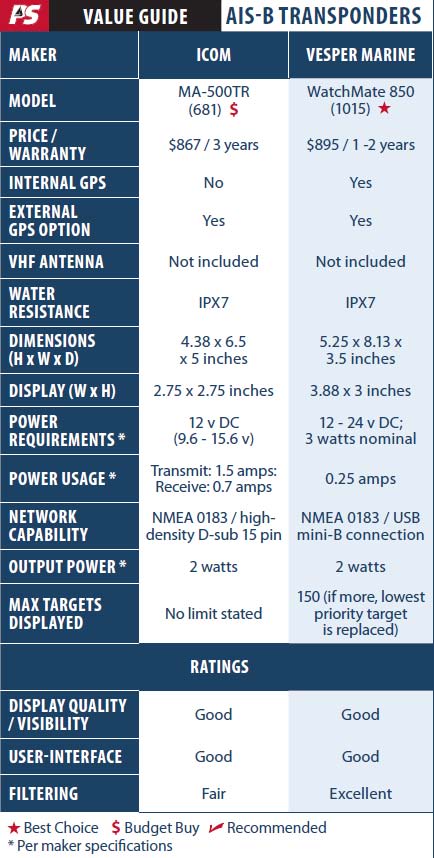
- Vesper Marine
RELATED ARTICLES MORE FROM AUTHOR

Safeguarding Sailors via Passage Guardian
The last time you’ve looked at AIS units was 2009 what kind of crap is that you need to update this right away this is completely ridiculous so, after all these years, you haven’t done a second review.14 years Between reviews is shameful. I’m not going to renew my subscription.
LEAVE A REPLY Cancel reply
Log in to leave a comment
Latest Videos
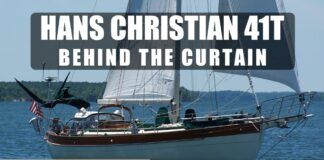
Hans Christian 41T – Boat Review

Seven dead after superyacht sinks off Sicily. Was the crew at...

What’s the Best Sailboats for Beginners?

Why Does A Sailboat Keel Fall Off?
Latest sailboat review.
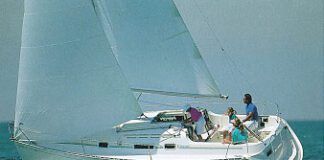
- Privacy Policy
- Do Not Sell My Personal Information
- Online Account Activation
- Privacy Manager

- Digital Yacht
Username or email address *
Password *
Lost your password? Remember me

- AIS Transponders
- All products
- AIS Accessories
- AIS Receivers
- Antenna Accessories
- VHF Splitters & Antennas
AIS transponders allow you to receive data from vessels close to you, but also to transmit your vessel’s identity, position, speed and heading as well as other relevant information to all other vessels equipped with an AIS system within your range. There are 3 types of AIS transponders: Class A, Class B and Class B+. They all interoperate.
Class A AIS are mandated for vessels over 300 tons, fishing vessels over 15m, passenger carrying vessels and for SOLAS Convention
AIS Class B are for recreational craft installation and have a transmission power of 2W (range of about 10 miles).
AIS Class B+ (also called Class B SOTDMA) use the same SOTDMA technology as a AIS Class A transponders and therefore have the same priority when it comes to reserving a slot, thus ensuring that they will always be able to transmit, even in high traffic areas. They have a transmission power of 5W.
Showing all 11 results
- Average rating
- Price: low to high
- Price: high to low
Price filter
- $ 0.00 - $ 650.00
- $ 650.00 - $ 1,300.00
- $ 1,300.00 - $ 1,950.00
- $ 1,950.00 - $ 2,600.00
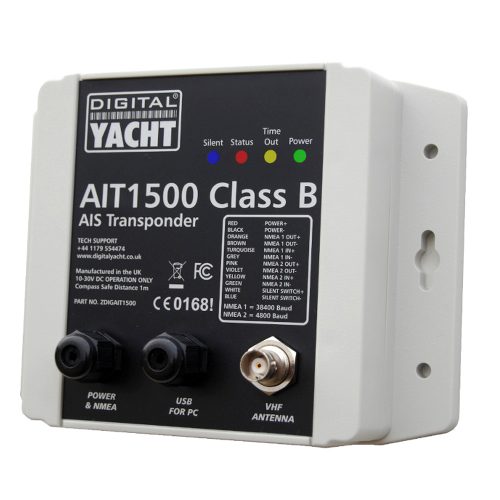
AIT1500 – AIS Transponder with built-in GPS & NMEA 0183
“Entry level AIS Transponder with industry standard NMEA0183 interface and internal GPS antenna that makes installation aboard smaller fibreglass (GRP) boats much quicker and easier.”

AIT1500N2K – AIS Transponder with built-in GPS & NMEA 2000
“An easy to install Class B AIS transponder with plug ‘n play NMEA 2000 interface. Built in GPS antenna and ideal for use on smaller yachts and boats like RIBs and center consoles.”
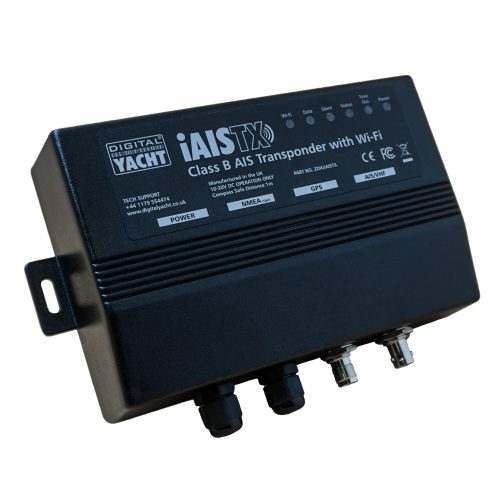
iAISTX – AIS Transponder with Wi-Fi
“iAISTX is an AIS transponder with a wireless interface designed specifically for the growing number of boaters who use a tablet for their navigation tasks.”
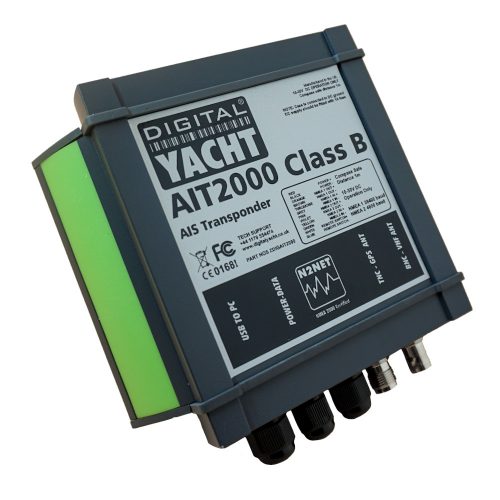
AIT2000 – Class B AIS Transponder
“The AIT2000 uses the latest AIS Transponder technology to squeeze more performance and interfacing options in to a housing that is half the size of our previous generation transponder.”
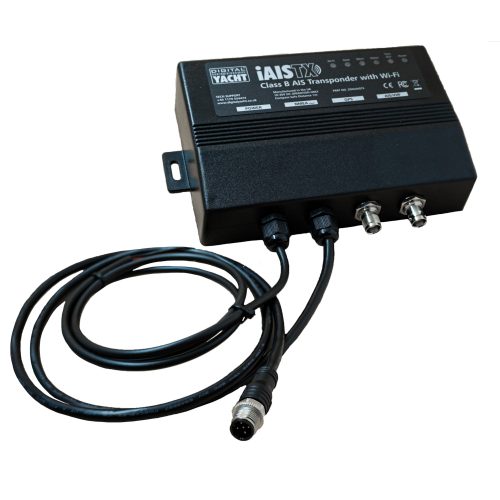
iAISTX Plus – AIS Transponder with Wi-Fi & NMEA 2000
“iAISTX Plus is an AIS transponder with a wireless interface for tablet & PC navigation and also has a NMEA 2000 interface (with integral drop cable) to integrate with modern plotters, instruments and multi-function displays to provide AIS functionality.”

Nomad 2 – Portable AIS Transponder
“Nomad 2 is a portable AIS navigation solution from Digital Yacht. It is a class B AIS transponder with a wireless and USB interface built in for tablets and PCs. It ships with a compact combination VHF and GPS antenna.“

AIT2000 + GV30 – AIS Transponder with VHF & GPS Antenna
“This AIT2000 plus GV30 bundle is ideal for smaller boats and tenders, providing a single combination VHF+GPS antenna solution that makes installation easy and simple.”
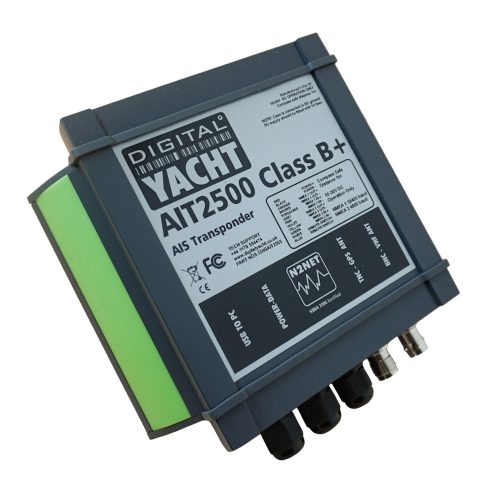
AIT2500 – Class B+ 5W AIS Transponder
“The AIT2500 is a full function Class B+ SOTDMA AIS transponder with NMEA 0183, NMEA 2000 and USB data outputs. It is supplied with a GPS antenna.”

AIB1000 – Self-contained AIS Transponder
“AIB1000 is a ruggedized, fully self-contained Class B AIS vessel tracking transponder – ideal for small vessel tracking and monitoring.”
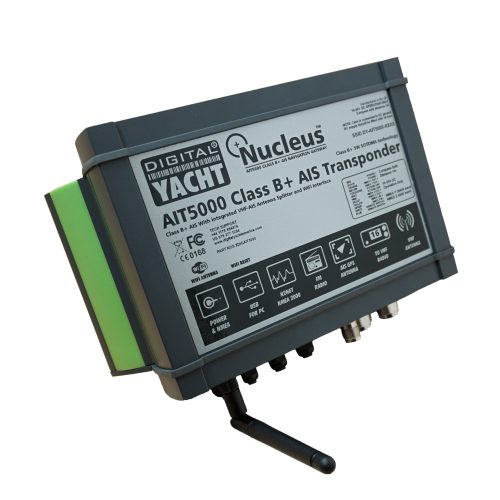
AIT5000 – Class B+ AIS Transponder with Wi-Fi, NMEA & VHF Splitter
“The AIT5000 is a Class B+ AIS Transponder with a 5W power output, a Wi-Fi interface, a built-in VHF splitter and utilises SOTDMA format transmissions.”
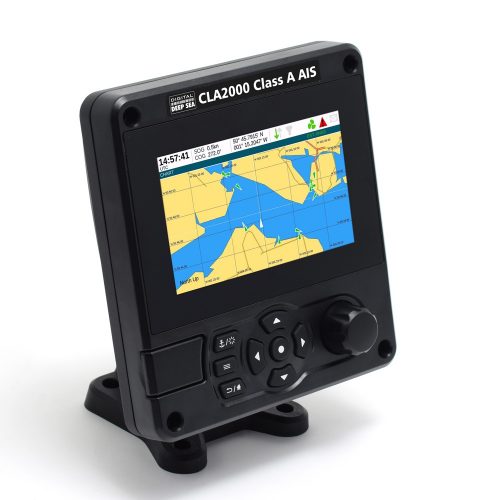
CLA2000 – Class A AIS Transponder
“CLA2000 is the ultimate SOLAS and inland waterway globally approved Class A AIS transceiver. “
- Automatic Identification System (AIS)
- PC on Board
- Portable Navigation
- AIS Beacons
- Multisensor
- NMEA to WiFi Servers
- NMEA Interfaces
- NMEA 2000 Cables
- SeaTalk Interfaces
- USB Interfaces
- 4G/5G Internet Access
- Hi Power Long Range Wifi
- Accessories
- PC Accessories
- TV Antennas
- PC Software
- Android Apps
- Antenna Mounts
- Connectors + Adaptors
- Instruments
- PC Navigation
- Internet Access
- Get Support
- Product Manuals
- Tech Support Notes
- Product Firmware
- Software and utilities
- USB Drivers
- WLN10 & WLN30
- Products with NMEA2000 interface
- How to configure apps & software?
- Product Registration
- General News & Events
- Product Information
- Applications
- Product Pictures
- Product Guide
- Login / Register
We value your privacy
Privacy overview.

IMAGES
VIDEO
COMMENTS
These yachts are constructed to be self sufficient in hostile seas. A Class B yacht ( boat ) is a vessel built to navigate on the offshore waters (200 miles and less) and can substain UP TO force 8 and waves UP TO 4 meters. A Class C boat is a vessel built to navigate inshore such as lakes, rivers, bays and close to the shore and can sustain UP ...
Class B (yachts over 50 ft): Sunnseeker 52 fly, 55 fly , 66 fly, 68 fly, Sport Yacht 74, 76 Yacht. Azimut 50 fly, 55 fly, 60 fly, S6 and all Atlantis. Princess : all yachts under 70 ft. Princess Y72, Y78 and less. Ferretti 580 fly. All Absolute. All Fairline. All Beneteau & Jeanneau & Monte Carlo 52.
Commercial yacht. A motor or sailing vessel in commercial use (i.e. charter) for sport and pleasure, carrying no cargo and not more than 12 passengers. Private yacht. A pleasure vessel solely used for the recreational and leisure purpose of its owner and his guests. Flag administration.
CE CLASS B yachts are designed to travel off the coast (200 miles or less) in which the winds can be up to force 8 (not exceeding) and waves can reach a height up to 4 meters (not exceeding). CE CLASS C boats are designed for travel close to the coasts and in large bays, estuaries, lakes and rivers in which winds can be up to force 6 (not ...
Owners moving from smaller yachts into those over roughly 80 feet will quickly learn a new alphabet: ABS, DNV, BV, LR, RINA, and more. These are organizations that set rules governing the construction, maintenance, and operation of yachts. Called "classification societies," there are 13 members of the International Association of ...
"Class B" Yachts are often called "offshore vessels" and are built for navigating coastal waters within 200 miles of the shore. "Class C" Boats are vessels built to navigate inshore and nearshore, including waterways such as lakes, rivers and bays, and generally can handle waves between 3-4 feet before they begin to get into trouble.
Yacht owners guide to Classification Societies. 21 January 2015 • Written by Benjamin Maltby. Alysia was built specifically for charter and complies to SOLAS. She can carry up to 36 passengers and is over 500GT. Classification societies (also known as 'class' societies) make an important contribution to maritime safety.
A classification certificate attests that the yacht complies with the standards developed and published by the issuing society. New construction and refit surveys carried out by a surveyor from the classification society under which the yacht is built are important inspections that take place at intervals throughout the duration of the project ...
As a consequence, it is either "in" or "out" of "Class". In summary, Class Notations on Yachts will tell you a lot about the building quality and condition of each vessel and its components on an annual basis, according to the excellence of its construction and its adjudged continuing soundness. A yacht that has been designed and ...
Offering you an unbiased and comprehensive yacht charter and yacht sales consultancy. www.salt-superyachts.com. [email protected]. +44 2038 821 364. Yacht classifications, also referred to as classification societies or class societies the that rules are an integral element of owning a yacht and an important part of maritime safety.
Not all of them class yachts, and of those who do, not all class smaller yachts. The American Bureau of Shipping (ABS), for instance, does not class yachts under 24 meters, or about 79 feet, in overall length. Each society also has different sets of rules and guides, several of which will be applicable to any given yacht.
Have you ever wondered what the different Beaufort scales are and what CE categories A, B C and D boats actually mean? In this video, I walk you through what...
Yacht classification is a system used to categorize yachts based on various factors such as size, construction, and intended use. The specific classification categories and requirements can vary between different yacht classification societies, but some common classifications include: Pleasure Yacht: A yacht intended for leisure use, typically ...
GUIDE FOR BUILDING AND CLASSING YACHTS JULY 2021 PART 3 HULL CONSTRUCTION AND EQUIPMENT American Bureau of Shipping Incorporated by Act of Legislature of
Comfort is a non-negotiable element for yacht owners and passengers, and this means ensuring limited onboard noise and vibrations. Yachts can earn Bureau Veritas' Comfort notation by undergoing an assessment of sources of noise and vibration, such as engines and propellers. Owners and yards can then take measures to improve ship structure and ...
The International B-class/F20 Catamaran, is a development class, on the comeback after the fracturing of the original B-class, ... In 1967, the then International Yacht Racing Union (IYRU, now ISAF) decided to run a week long series of trials (August 5-12) to determine the best "A" and "B" classes of catamaran design to be selected for ...
3 - The New Class B+ Technology. The new Class B+, often referred to as "Class B SOTDMA" or "Class B 5W", has been defined to bridge the gap between Class A and Class B transponders, offering some clear advantages for some types of vessels and applications. Class B+ uses the same SOTDMA technology as Class A and therefore has the same ...
AIS transceivers are split into Class A (commercial) and Class B (recreational), and they broadcast information from every 2 to 30 seconds. Class A transceivers have a maximum VHF power output of 12.5 watts, are required to broadcast more data than Class B units, and must update data more frequently than Class B. Class B transceivers are ...
Nomad 2 - Portable AIS Transponder. $ 949.95. "Nomad 2 is a portable AIS navigation solution from Digital Yacht. It is a class B AIS transponder with a wireless and USB interface built in for tablets and PCs. It ships with a compact combination VHF and GPS antenna.".
The unique ice-class luxury yachts of the Radisson Royal Moscow Flotilla navigate the Moscow river 365 days a year, regardless of the season or the weather outside. Gorky Park Pier is the second pier in the city from where the Flotilla yachts depart. Let yourselves be amazed by the stunning views and the elegant mastery of our chef as you pass through the very heart of Moscow surrounded with a ...
Flotilla "Radisson Royal" has 10 perfectly equipped yachts designed for year-round entertaining excursion cruises on the Moscow River with restaurant service aboard. Our company organizes cruises 365 days a year. Flotilla "Radisson Royal, Moscow" combines picturesque views of Moscow sights with excellent catering service.
Show more. Flotilla Radisson Royal: Cruises and excursions on Moscow River on river yachts and trams, official website. Cruises all year round, in summer and winter! > Purchase tickets online.
Interested in renting a yacht in Moscow? Rent for an hour is 49,000 rubles. Yar-Yachting Company. PHONE: +7 (967) 033-72-21. Go to the website faster! Skip to content +7 (967) 033 7221; ... RENT THE EXCLUSIVE LUXURY CLASS YACHT. Premium yachts in Moscow and the suburbs. Dinner Date.